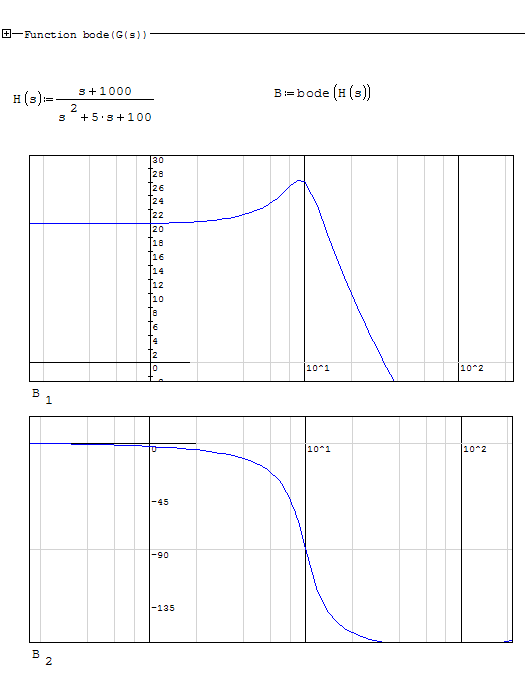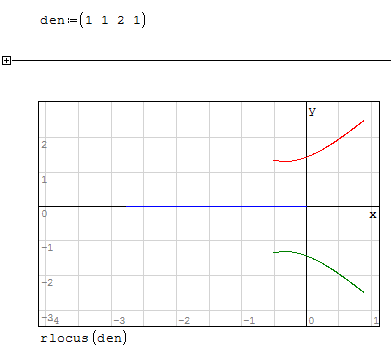Signals and Systems - Example of use of SMath for signals and systems analysis - Сообщения
#1 Опубликовано: 29.05.2012 16:14:49
Hi, this is a snippet for numerical inverse Laplace transform. You can find time response of a system expresed in F(s) form.
enjoy

Download it here
Regards,
Oscar Campo
enjoy

Download it here
Regards,
Oscar Campo
3 пользователям понравился этот пост
kmihaylovich 30.05.2012 02:28:00, Davide Carpi 29.05.2012 18:13:00, Radovan Omorjan 30.05.2012 03:00:00
#2 Опубликовано: 30.05.2012 03:09:26
Hello Oscar,
Thank you for this example
By the way, I find very interesting that you defined an expression in this way an then plot it:

ft() looks like a function, but it is not.
Regards,
Radovan
Thank you for this example
By the way, I find very interesting that you defined an expression in this way an then plot it:

ft() looks like a function, but it is not.
Regards,
Radovan
When Sisyphus climbed to the top of a hill, they said: "Wrong boulder!"
1 пользователям понравился этот пост
Davide Carpi 30.05.2012 07:29:00
#3 Опубликовано: 30.05.2012 07:10:43
Yes, it's something that I found accidentally. The statement ft(F(s)) appear as a function, but it's a matrix!
Oscar
Oscar
#4 Опубликовано: 30.05.2012 15:18:43
Hello,
I tried to open it using the latest SMath.
I get an error message in the last FOR loop: "Function not defined"
Thanks,
Basile
I tried to open it using the latest SMath.
I get an error message in the last FOR loop: "Function not defined"
Thanks,
Basile
#5 Опубликовано: 30.05.2012 15:53:17
[USERLINK]Basile[/USERLINK], you need to define a function to work with as shown in the first message.
Regards.
Wrote
Regards.
#6 Опубликовано: 31.05.2012 21:25:59
Thank you Andrey,
Basile
Basile
#7 Опубликовано: 31.05.2012 21:28:48
Oscar,
Which Numerical Inverse Laplace Transform do you use?
Any reference?
Thank you,
Basile
Which Numerical Inverse Laplace Transform do you use?
Any reference?
Thank you,
Basile
#8 Опубликовано: 01.06.2012 09:24:33
Hi Basile,
The method is based on work of J. Valsa and L. Brancik: Approximate Formulae for Numerical Inversion of Laplace Transforms, Int. Journal of Numerical Modelling: Electronic Networks, Devices and Fields, Vol. 11, (1998), pp. 153-166
Regards,
Oscar
The method is based on work of J. Valsa and L. Brancik: Approximate Formulae for Numerical Inversion of Laplace Transforms, Int. Journal of Numerical Modelling: Electronic Networks, Devices and Fields, Vol. 11, (1998), pp. 153-166
Regards,
Oscar
1 пользователям понравился этот пост
Davide Carpi 01.06.2012 09:32:00
#9 Опубликовано: 01.06.2012 17:29:58
Oscar,
Thank you,
Basile
Thank you,
Basile
#10 Опубликовано: 04.06.2012 19:47:33
Bode Diagram Revisited.
This is a function for graphing the Bode plot of a system. Please plot the magnitude and phase on a diferent graph each one, deactivate "grid" and "axis" for a better visualization of logarithmic grid.

Download it here: MyBode3.sm (30 КиБ) скачан 62 раз(а).
This is a function for graphing the Bode plot of a system. Please plot the magnitude and phase on a diferent graph each one, deactivate "grid" and "axis" for a better visualization of logarithmic grid.

Download it here: MyBode3.sm (30 КиБ) скачан 62 раз(а).
#11 Опубликовано: 05.06.2012 15:02:37
Root Locus Snippet
This is a snippet for plotting Root Locus of a sistem. The input is the denominator of coefficients of transfer function:

Download it here
Oscar
This is a snippet for plotting Root Locus of a sistem. The input is the denominator of coefficients of transfer function:

Download it here
Oscar
#12 Опубликовано: 25.08.2017 13:22:41
The file seems to be locked, I can't put a equation.
#14 Опубликовано: 25.08.2017 18:44:35
WroteThe file seems to be locked, I can't put a equation.
Open the file in SMath Studio and then go to File > Properties > File Attributes and uncheck Read-only. This attribute is required when the worksheet is designed to be a snippet.
If you like my plugins please consider to support the program buying a license; for personal contributions to me: paypal.me/dcprojects
#15 Опубликовано: 26.08.2017 09:01:49
#16 Опубликовано: 27.08.2017 10:46:55
Wrote
=================
This 5 years old document does not work 6179.
Only a very little detail to fix this 5 years old document: declare F(s) and change the last line on snippet:
ft( "F(s" ) = augment(t,ft)
for
ft() = augment(t,ft)
You can download the updated version from here
1 пользователям понравился этот пост
Davide Carpi 28.08.2017 13:28:00
#17 Опубликовано: 28.08.2017 11:01:53
WroteYou can download the updated version from here
... that's only several pages long of HTML code.
No work sheet. Best is to upload WS in the forum.
For "Laplace stuff", better use maple(,) as show above.
Cheers, Jean
#18 Опубликовано: 28.08.2017 11:32:53
Wrote
... that's only several pages long of HTML code.
No work sheet. Best is to upload WS in the forum.
Use "save as"
Цитата
For "Laplace stuff", better use maple(,) as show above.
Yes, and also it’s possible use f(t)=Maxima(ilt(F(s),s,t)) but it’s interesting show how you can implement inverse Laplace of a function in SMath.
P.D. The symbolic form of f(t) obtained from ilt() it’s more “elegant” than maple version
1 пользователям понравился этот пост
Davide Carpi 28.08.2017 13:28:00
#19 Опубликовано: 28.08.2017 13:04:34
Win 7 does not have the virtue to save HTML "save as" *.sm
OK: no work sheet => nothing to see. Tanks anyway.
Cheers, Jean
OK: no work sheet => nothing to see. Tanks anyway.
Cheers, Jean
#20 Опубликовано: 28.08.2017 13:24:42
WroteWin 7 does not have the virtue to save HTML "save as" *.sm
You can if you use firefox (with chrome you have to change the extension manually from .txt to .sm);
However I've edited the link, now it downloads the file, whatever is your favorite browser.
If you like my plugins please consider to support the program buying a license; for personal contributions to me: paypal.me/dcprojects
1 пользователям понравился этот пост
Oscar Campo 28.08.2017 14:23:00
-
 Новые сообщения
Новые сообщения
-
 Нет новых сообщений
Нет новых сообщений

